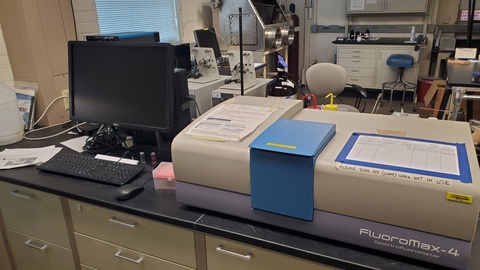Main navigation
The Department of Chemistry manages a shared instrumentation facility housing instruments available for use by faculty and students.
The instruments are listed by lab room location in the Chemistry Building in the following section. Please review the information by instrument for more on sample submission documentation, rates, training, and other useful resources for the instruments in our facility.
Instruments by location
- Shared Chemistry Laboratory–W443 Chemistry Building (CB)
- Jasco DIP-1000 Digital Polarimeter
- Agilent Technologies Cary Series UV-Vis-NIR Spectrophotometer
- Wyatt Dawn Heleos II Light Scattering Detector/Photometer (GPC)
- Fluoromax-4 Spectro-Fluorometer
- Our Exeter Elemental Analyzer and RADWAG Microbalance MYA 21.3Y (20g limit) have been moved from Chemistry to the MATFab Facility in the Iowa Advanced Technology Laboratories (IATL).
- Molecular Force Probe 3D Classic (MFP-3D) AFM from Asylum Research
- Shared Biochemistry Laboratory–W281 Chemistry Building (CB)
UI rates
- Cary UV-Vis: $5 per hour
- Fluro spectrometer: $5 per hour
- GPC (Dawn Helos): $12.50 per hour
- Autoclave: $2.50 per run
- GE Microcal iTC: $20 for 3 hours
- Nanodrop: $5 per hour
- nCS1: $25 per cartridge + $10 day charge
- Atomic Force Microscope (AFM): $10/hour
Outside rates
We are happy to accommodate labs from outside of the University of Iowa. Additional rates may apply. Labs within the department/university may be given priority if necessary.
Learn more about our instruments
Autoclave

The Market Forge STM-E is a popular, durable, electric steam pressure sterilizer (autoclave) known for its large capacity in a compact footprint, ideal for labs, clinics, and vet offices, automatically achieving 250°F (121°C) for efficient sterilization of instruments, glassware, and liquids, featuring simple controls, low-water cut-off, and quick/slow exhaust options for different loads.
Key features & specs
- Capacity: Large interior (e.g., 16" x 26" chamber) with significant cubic inches (approx. 85L)
- Temperature: Fixed at 250°F (121°C).
In essence, the STM-E offers robust, reliable, and large-capacity sterilization for diverse needs, balancing power with operational simplicity.
Contact Mike Estenson at michael-estenson@uiowa.edu for training and usage.
Atomic Force Microscopy (AFM)

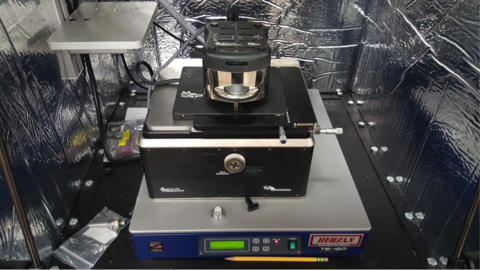
Model: Molecular Force Probe 3D Classic (MFP-3D) AFM from Asylum Research, Santa Barbara
Brochure, procedures, and operation manual: These resources are available via Asylum Research.
The Molecular Force Probe 3D Atomic Force Microscope is a scanning probe microscopy instrument that is capable obtaining 3D height, amplitude, and phase images with 1 nm spatial and 1 pN force resolution, respectively. The high resolution is achieved by using a very sharp AFM probe that can raster scan the surface, either with tapping or contact mode.
Since its conception, it has been widely used in both academic and industrial settings for its amazing imaging capabilities. For example, its current applications can be widely found in materials science, environmental/atmospheric chemistry, life science, and other advanced applications.
Specific examples on how the AFM is currently being used in the UI Department of Chemistry are visible on the Tivanski Research Group website. Whatever the application, the AFM provides the users with cutting-edge imaging capabilities for discoveries in nanoscience, environmental/atmospheric chemistry, and biochemistry.
Were you expecting to find a resource for this instrument here but didn’t find it? Please contact Mike Estenson at michael-estenson@uiowa.edu and let us know!
Cary UV-Vis/NIR
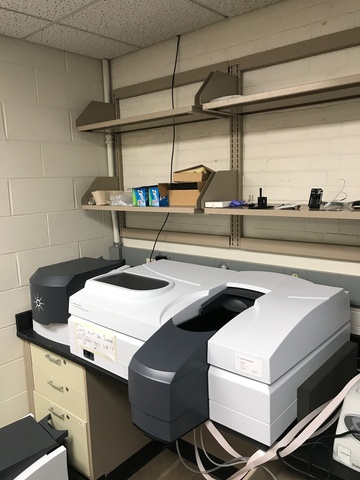
Model: Agilent Cary 5000
Resources: Brochure and diffuse reflection apparatus user manual (Note: This user manual carries some information from older models, but also includes good theoretical information for your use.)
Wavelength range: 175-3300 nm
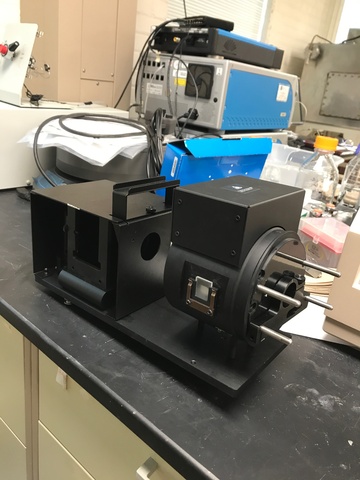
The Cary UV-Vis/NIR has a broad range of applications that can suite your research needs. This instrument can measure optical densities of above 8.0 using reference beam attenuation, has temperature control, and has the ability to measure diffuse and specular reflection, along with angular specular reflection on solid samples.
Were you expecting to find a resource for this instrument here but didn’t find it? Please contact Mike Estenson at michael-estenson@uiowa.edu and let us know!
Dawn Heleos II Multi Angle Light Scattering (GPC)
The DAWN® HELEOS® II is the premier Multi-Angle static Light Scattering (MALS) detector for absolute characterization of the molar mass and size of macromolecules and nanoparticles in solution. The DAWN offers the highest sensitivity, the widest range of molecular weight, size and concentration, and the largest selection of configurations and optional modules for enhanced capabilities.
The DAWN is most often used in conjunction with Gel Permeation Chromatography (GPC-MALS) or Size Exclusion Chromatography (SEC-MALS) or Field-Flow Fractionation (FFF-MALS) to determine distributions of mass, size and composition independent of column calibration by reference standards.
The DAWN HELEOS II and its companion Optilab T-rEX dRI detector are the established benchmarks for MALS analysis, cited in thousands of peer-reviewed publications. Multi-angle light scattering detection is indispensable for use with GPC and HPLC-SEC in order to obtain reliable molecular mass distributions and information on molecular conformation, branching ratio, fragments and aggregates.
SEC-MALS with a HELEOS II and Optilab characterizes conformation and branching of synthetic and natural polymers larger than 10 nm in rms radius Rg. The addition of a ViscoStar III differential viscometer creates a GPC triple-detection system can analyze molecular conformation and size below the rg limit of 10 nm and determine Mark-Houwink Sakurada coefficients.
The combination of a UV/Vis absorbance detector with a HELEOS and Optilab refractive index detector creates a UV-MALS-RI triple-detection system, for analysis of copolymers and protein conjugates (glycoproteins, PEGylated proteins, surfactant-bound membrane proteins, etc.). With the addition of a WyattQELS DLS module for size determination, protein conformation may be analyzed.
The DAWN may also be used in batch (off-line) mode to characterize the weight-average molar mass, z-average size and second virial coefficient of unfractionated samples.
Included with each DAWN is a copy of ASTRA, the most versatile software package available for analysis of online multi-angle and dynamic light scattering.
- Mw from 200 Da to 1000 MDa
- Sensitivity: 0.4 µg/mL BSA (66.4 kDa)
- rg from 10 to 500 nm, up to 1000 nm with shape-specific models
- Ultra-stable, high-power laser
Instrument cluster includes:
- Wyatt Dawn Helos-II
- Wyatt Optilab T-Rex
- Wyatt QELS
- Waters HPLC Pump, including 1 spare Pump
For questions and training, contact Michael Estenson at michael-estenson@uiowa.edu.
ATRA software guides:
Were you expecting to find a resource for this instrument here but didn’t find it? Please contact Mike Estenson at michael-estenson@uiowa.edu and let us know!
Exeter Elemental Analyzer
Our Exeter Elemental Analyzer has been moved from Chemistry to the MATFab Facility in the Iowa Advanced Technology Laboratories (IATL).
Fluoromax-4 Spectro-Fluorometer
Jasco DIP-1000 Digital Polarimeter

Contact Mike Estenson at michael-estenson@uiowa.edu for more information, including to request a resource for this instrument be posted online.
MicroCal iTC200
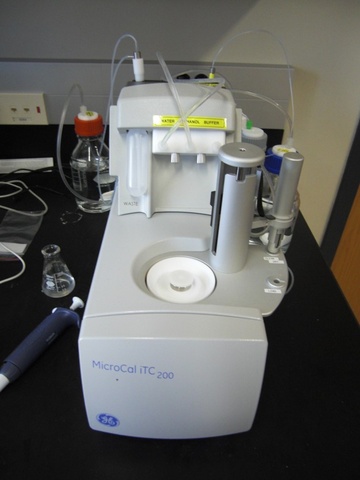
Maker: Malvern, formerly GE
Resource: Watch how ITC works
The MicroCal iTC200 is a highly sensitive, low volume isothermal titration calorimeter for the label-free in solution study of biomolecular interactions. It delivers direct measurement of all thermodynamic binding parameters (ΔH, ΔS, equilibrium constants, and stoichiometery) in a single experiment and can analyze weak to high affinity binders, using as little as 10 µg sample.
Were you expecting to find a resource for this instrument here but didn’t find it? Please contact Mike Estenson at michael-estenson@uiowa.edu and let us know!
NanoDrop OneC

Resources: Manual and quality assessment video
Prevent costly delays with an enhanced understanding of sample quality using the Thermo Scientific™ NanoDrop™ One Microvolume UV-Vis Spectrophotometers. Innovative Thermo Scientific™ Acclaro™ Sample Intelligence technology is built into every instrument for improved measurement accuracy and contaminant identification. Quantify and qualify DNA, RNA, and protein samples in seconds with only 1-2 µL, and obtain full-spectral data before you decide to use samples in downstream applications. Additional cuvette position also available with temperature control.
Were you expecting to find a resource for this instrument here but didn’t find it? Please contact Mike Estenson at michael-estenson@uiowa.edu and let us know!
nCS1 Nanoparticle Characterization

Spectradyne's nCS1 instrument provides a unique platform for the rapid quantitative measurement of nanoparticles in solution. The method used to measure nanoparticles is electrical in nature, so does not rely on an optical index contrast to distinguish particles from their suspending medium. The instrument measures individual nanoparticles and rapidly accumulates statistically-reliable distributions of particle sizes with quantitative concentration information. This unique capability separate the nCS1 from any other instrument on the nanoparticle analysis marketplace.
Key features:
- Resistive pulse sensing and size measurements of individual nanoparticles in fluid
- Disposable microfluidic cartridge that avoids cross-contamination
- Reports particle size distribution with absolute concentration
- Particle sizes: 40 nm to microns in diameter
- Concentration range: approx. 106 — 1012 particles/mL
- Max particle detection rate: approx. 10,000 particles/s
- Nanoparticles of any material type (transparent & opaque, conducting & insulating)
- Bench-top footprint
- Line power (110V & 60 Hz | 220 V & 50 Hz)
- Dimensions: 13" wide × 13" deep × 15" high (330 mm wide × 330 mm deep × 380 mm high)
- Weight: 30 lbs (14 kg)
- Instrument control interface: USB to Windows
| Part Number | Size Range (particle diameters) |
|---|---|
| TS-300 | 50-300 nm |
| TS-400 | 65-400 nm |
| TS-2000 | 200-2000 nm |
Learn more from Nanoparticleanalyzer.com
Were you expecting to find a resource for this instrument here but didn’t find it? Please contact Mike Estenson at michael-estenson@uiowa.edu and let us know! You can also contact Mike for training and scheduling.
Contact us

